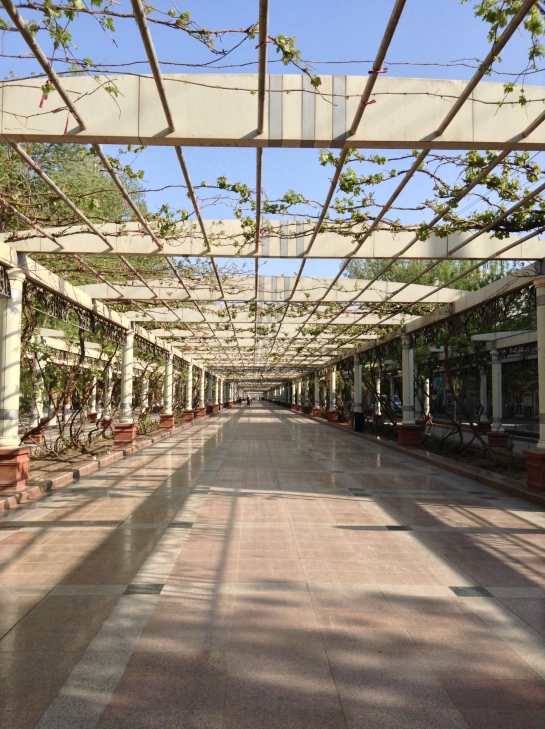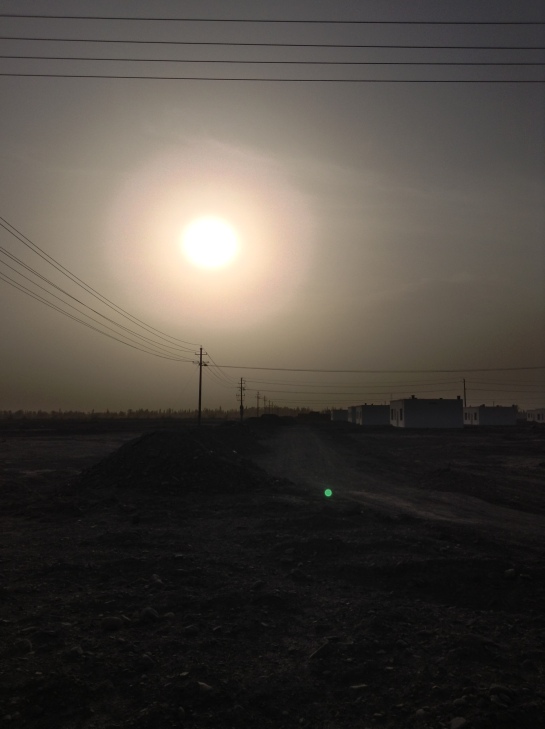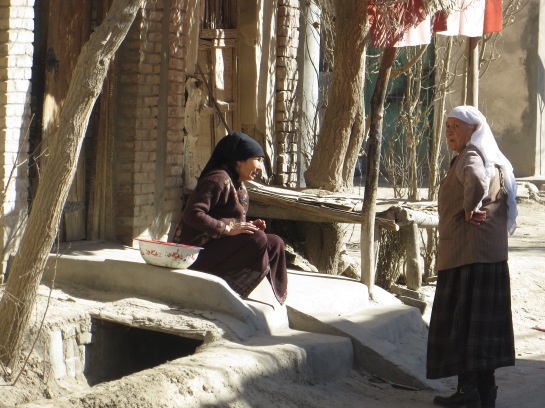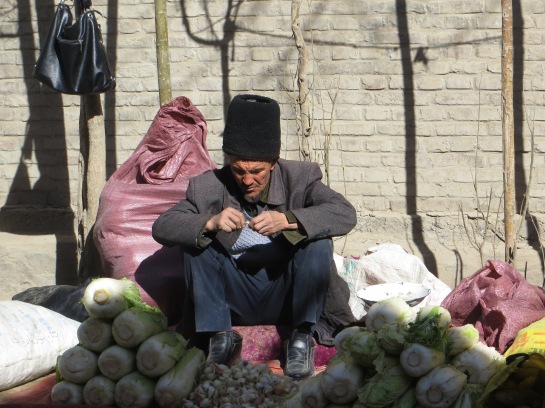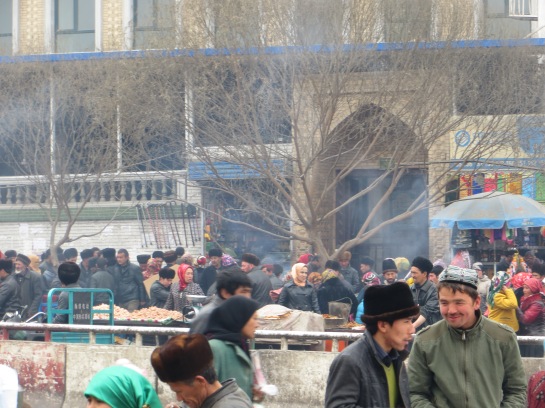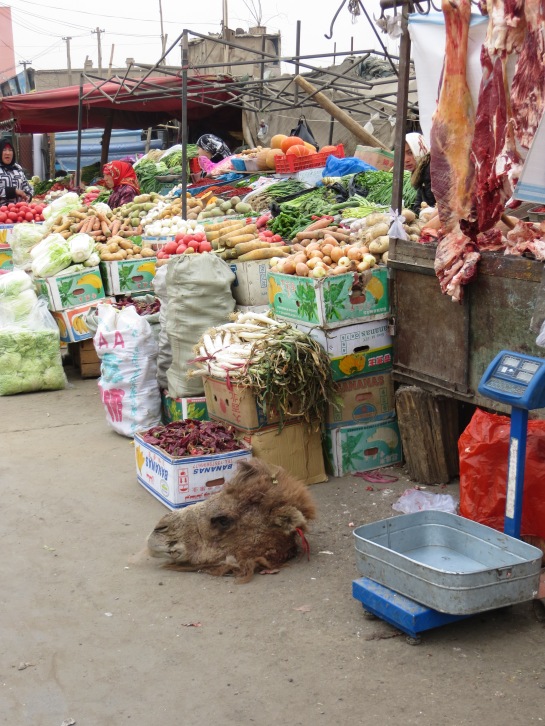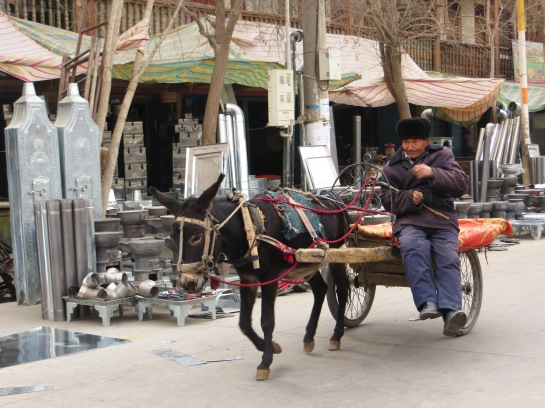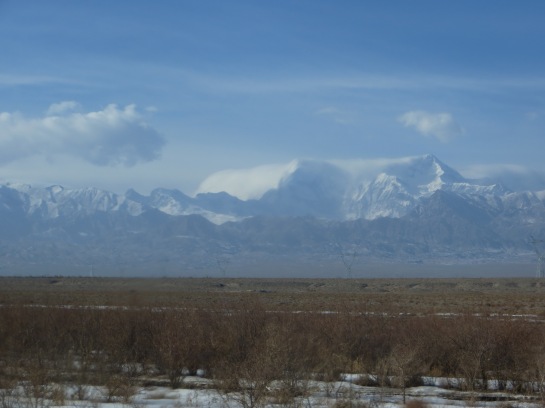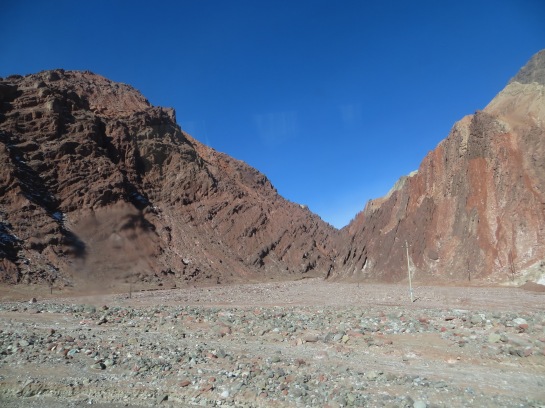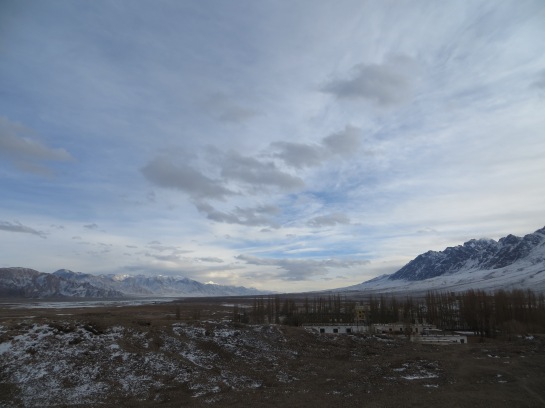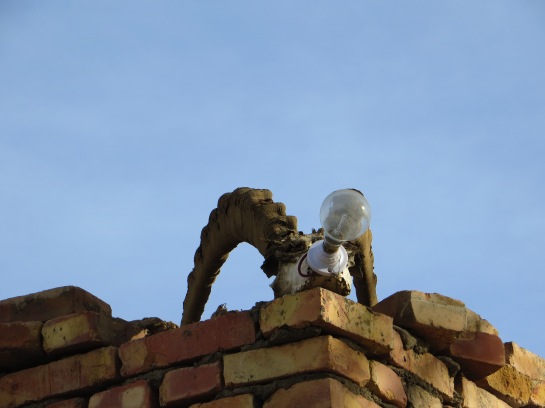Recently my mother asked if the Bachu incident would hinder my summer travels (most likely from Southern Xinjiang to Kyrghyzstan and Uzbekistan).
Nope, unlikely.
Because the Chinese government expects this kind of thing – they’re always on guard against it, and use the possibility as an excuse to bolster their force (especially police/spy force) in the region. If something like this didn’t happen once in a while, that would actually be more unusual. Because the government is expecting it. So when something does happen, rather than bringing in new codes or measures, it just legitimizes those already in place.
Which got me to thinking – incidents like this actually serve the government’s interests.
Yep. By reinforcing (legitimizing) the regime’s assertion of need for more control and heavier government supervision in the region, this incident is actually beneficial for the state. Without incidents like this, the heavy presence of the state would be questioned, resented. But when there are incidents, the state can use them (and does use them) to legitimize their otherwise questionable role and presence in society.
How?
First, occasional incidents create fear and a perpetual sense of insecurity – both among Han Chinese (fear of “the other”) Uyghurs (fear of the extreme, need of “outside” protection). If there is a long period without incidents, this fear will wain, and general civilians will start to believe that they don’t need the government’s protection. Though if incidents occur – even small incidents or ‘potential incidents’ (like the thwarted plane-hijaking in Hotan last year) – the public’s sense of fear will flare up – the threat is real – and, with limited options, they will again seek the government’s protection.
For Han Chinese (and a few non-Muslim minorities, like the Mongolians), incidents like this re-enforce the stereotype that Uyghurs pose potential danger, that they are a wild group, something that must be monitored and contained. For Uyghurs, especially urban, modern or moderate Uyghurs, the supposed presence of violent extremists who threaten to shake the social order and the stability (job-family-house) that they try to build in their middle-class lives, will actually tip them towards the government’s arms. Much as some people believe that 9/11 was meant in part to push moderate Muslims towards extremism (by perpetrating persecution and prejudice), so do these incidents push moderate Muslims towards the government, by contrasting “uneducated village terrorists” with modern, secure middle-class society as represented by stable jobs in national work units and “routine life”.
After the incident Chinese microblogs and Wechat (basically an Asian WhatsApp) moments were filled with commemorations for the police officers and village community workers who died, along with stories about what good mothers and filial children they were, with (mostly Uyghurs) expressing reverence for their sacrifice and honor for their sense of duty to protect the people. When one student commented questioningly on one such one post, the poster fired back “So, what, you sympathize with the terrorists?!”
Which gets to the next point: occasional incidents also re-inforce the government line that (1) there are terrorists in the area; that (2) those terrorists are potentially dangerous to everyone and that (3) – assumedly- these groups (and they are “groups”, not individuals) are religiously (not politically or legally) motivated. This in turn – threat and thus fear stemming from religion – strenghtens the government position that religion is a source of danger and must be monitored by the government in order to protect the people. Which justifies strict laws on religious practice. The motto seems to be: inconvenience on occasion guarantees safety for society. And fear or actual threat of terrorism shifts part of the population from resentment to acceptance.
I’m not suggesting that the government created the incident – just that it often uses such incidents to bolster certain agendas. And this incident in particular is quite conveneint.
In several ways it was “the perfect incident”.
First, it was easily contained. The incident took place in a small town without much outside contact. The town was easily corridored off, and hard to access for journalists (see the earlier BBC report). Thus, there’s little possibility of a flare, or news spreading like wildfire across the sands.
Second, it was small-scale. The incident claimed twenty lives within a few hours. Twenty isn’t two or three – but it’s still fairly minor compared to the riots four years ago. Of those twenty, one third were civilian perpetrators and two thirds were minor neighborhood police workers. There were no onlookers or figures of relative importance involved.
In fact, no one really saw the incident and there are no eyewitnesses left. There is no one living who was present for the entire scene, no one who can recount exactly what happened in the house, or state what provoked the incident, and certainly no one left to corroborate or contradict government accounts.
Which does make the incident seem almost a little too convenient – it greatly served political agendas, and at minimal cost.
Tag Archives: Xinjiang
Huh.
Looking for news as to why there have been so many police patrolling Urumqi the past few days (more than the usual many anyway), I came across this:
A different account of the Bachu “terrorist attacks”
It still doesn’t answer my quetion – why there has been a police van stationed at the entrance of our university for three days, why there are police vans at the bus stops downtow, why there are police checking Uyghur’s IDs at restaurants around the bazaar today. But interesting nonetheless.
As to the increase in police – this happens every time “something” happens – we never hear about it (this thing never makes it to the official news), just notice the increase in armed police as rumours fly.
Turpan, Round II, Part I
Turpan, Thursday
At first seemed a boring on second round, partially because of current location. My friend’s family is originally from a small village (by small, I mean it has three dirt streets and fifty households, within which the residents of most are related to most everyone else. Yet another case of “that’s my cousin. Oh look, there’s another one of my cousins… And hey, there’s my aunt!”.

The city itself I honestly like; it has this intrinsic livability and authenticity about it (save the industrialized north part where all the raisin warehouses are located). There’s a bustling, lived-in market, tree-shaded streets, and lots of local alleys on the south side of town to explore. The edges of town too are nice – lots of shade-dappled lanes where desert laps at the oasis. It’s boisterous, dusty, laid-back. It’s not ideal, but it’s nice for Xinjiang.

The village itself is textured, if covered in dust from the three days of thick wind. Houses made of us brick run parallel along both sides of a tree-shaded stream where children play on rope swings and women do the wash. But my friend’s family just bought a new house, a white tiled thing with high ceilings and half-finished walls in the middle of a plot of dust. This plot of dust is slowly being turned into a farm by my friend’s half-retired father, with a few irrigation ditches and scraggly promises of apple trees, a thousand chickens and a pen of a hundred or so goats. But it’s still basically a big plot of dust. And when I arrived i decided I’d rather be in the city (which is not so big) free to wander around than staring at the scrub brush. I wanted to come to Turpan to vacation, to explore or see beautiful scenery. Here, aside from the village, there’s near nowhere to go. The village’s only store is a magazine and snack kiosk currently shuttered and locked.
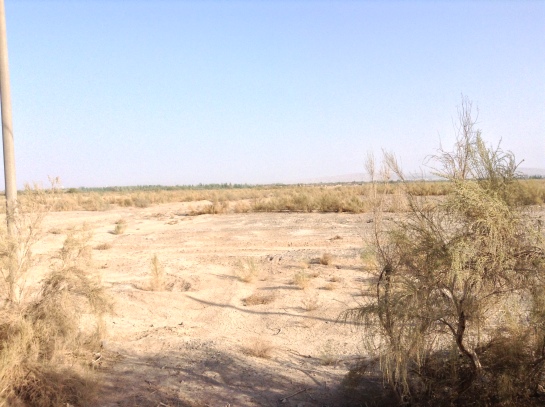

However, being there is still interesting, from a historians point of view. Perhaps not exciting, but offering of insight. So this trip ended up being less about being a tourist, and more just being there, seeping in the sand and culture or Turpan for a few days.
Adil’s father grew up in the village, spent his adult life in Urumqi with a cushy job as a middle manager at a state-run factory, and a year and a half ago shocked his family by buying a plot of dust and starting a farm. He still works every other month, but he manages to make it out to the farm about six months out of the year, wife in tow.
When his parents are gone (back in Urumqi) the farm is run by a local middle-aged man with a slap-happy smile, a hired farm hand with no land or other occupation of his own who is paid generously, willingly, by them. When meals are covered, twenty thousand a year stretches much further here than in Urumqi, where salaries for manual laborers are about the same. In terms of finances, peoplehere seem far less anxious than those in the cities – perhaps because no one here is pressurded to buy apartments or feels the press of heavy population. The countryside affords space, space to spread out and unfurl, space even to waste. The living room in their house (“dance and meeting room” for when festivities come) is the same size as S’s entire apartment, for which she pays as much as Adil’s entire monthly salary.
And yet, every day the cousins – all of them grape/raisin farmers – come by on their motorbikes and three-wheel scooters (the Xinjiang equivalent of a pickup truck) or on foot – some of them live just five minutes walk away – to check out the goats or gather for dinner. Not an hour goes by when somebody doesn’t drop by or another relative shows up to help in the field. Farm life is communal; despite the space, here there are no “lonely ranchers of the western range”.
Most farmers in the village are very poor when measured quantitatively. Profits are low, especially with outside middle-men coming into the grape and raisin industry. All houses in this area are without running water, sewage and gas – cooking is still done over wood or coal. The mother, who isn’t too fond of the inconveniences of the county lifestyle, complains about the amount of time she spends preparing food, cooking, and cleaning up after meals every day. (“After I retired, I wanted to start traveling around China”, she confessed, “but now I have to come here when my husband’s off work and feed all the men”). She’s used to their factory-provided breakfasts and dinners, to the convenience of having a supermarket just five minutes away from her doily-covered kitchen. And yet even here their family eats relatively well, while some actual farmers in the village apparently can’t cover the table. The first night we had dapanji and Adil commented that this was really special for the cousins and worker eating over, as they rarely eat meat, since meat is so expensive here. The staples are bread, rice (with eggs) and noodles. It’s not like the city, where we have the luxury of choice. Even the little bit of urban Turpan does not experience this want; the discrepancy in development between Turpan city and the villages sixteen kilometers outside is huge: modern conveniences versus none, choice versus none, anonymity versus absolute familiarity. And yet people here, knowing nothing else, are genuinely happy. Occasionally worried about harvest or rain or some sheep’s illness, but not discontent with their way of life or their allotment.
Yet, when they come, Adil’s parents provide that contrast. They may live like locals in terms of external appearance while in the countryside: simple (albeit new) lodging, simple food cooked over a coal stove, working on the land themselves. And yet the subtle differences draw all the more attention to the disparity between their lives and those of the real local farmers. His mother, a former chemist in charge of checking gas quality at China Petrol, has huge pearl drops dangling from her ears and a string around her neck even when washing dishes and chopping carrots in dirty jeans. They can afford better food brought from the city and a large light kitchen full of pans. The father labors all morning in a straw-colored shirt and pants stained with dust, then spends his mid-day nap in front of a huge flatscreen TV. Their entire existence here is rife with small tensions – the inconveniences of the countryside and cooking without running water, going back to one’s roots on the land, the ideal of a simple and wholesome country life after retirement and being accustomed to the comforts of the city, poverty and relative wealth, the mother’s frustration at what she sees as stagnation (as opposed to what the farmers cherish as continuity), farming out of dust and the ever hanging threat of drought, change and permanence, modernization and tradition, culture and cultural obligation.
Friday morning Adil and I headed into Turpan to see the museum. As it doesn’t open until 11:30, and we arrived at ten, we first wandered around town.
Turpan always feels like a market town, regardless of the day of the week. In the morning people open up shop, slowly start to bustle around, beggars on the sidewalks competing with fruit sellers and shoe shiners for your change, shops that can’t be shuttered inside spilling on to sidewalks, bolts of embroidered fabric and slices of watermelon, strawberry ice cream a scary synthetic pink and children crying after the cheap cream-topped cakes ubiquitous across Xinjiang. Today I saw a toddler escape from his mother’s grasp and fling himself at a small cake stand crying “toooorta, tooooorta, tooorta!”, and grab a cake cup so hard the half-done plastic top popped off, fat red tears running down his face when his mother scooped him back up.
The museum, however, is both terrible and mundane. The architecture is grand: Adil joked that we’d stepped into Dubai. But the displays are as gaudy, with flashing neon lights, as a country fair booth. The tourists toting professional cameras are raucous, loud and self-important after descending from the behemoth white tour buses toting them around Xinjiang. Kids run up and down the grand halls shouting and screaming while their parents snap photos and yell at each other about better photo ops. I told Adil that, to westerners, their behavior was practically sacrilege, stomping on the intrinsic sanctity of museums (I wonder how the British museum handles bus loads of Chinese tourists?).
Then it was back to wandering around town, picking up giant pears crunchier and sweeter than the winter leftovers in Urumqi, having crispy tofu and bad liangpi, and picking up some vegetables and supermarket essentials for the village before heading back to play frisbee in the dry desert heat of an intensely sunny afternoon.
Post-frisbee I was preparing to do some work (somehow I still always think this will happen on vacation…) when the cousin’s mother and her youngest, a daughter, came over to see the foreigner, look through my pictures, and kidnap me back to their house for dinner.
The cousin’s mother is an elementary teacher for music and Uyghur language class at the local primary school. She always dresses in velvet with a gauzy scarf covering her hair, like a dark halo above her chipmunk smile, and walks with a slight limo from a car accident. Her daughter is an extremely tall and lively fourth grader at the same school. Neither of them can speak much Chinese, which is unfortunate for my Uyghur is even worse. Back at their house (with Adil’s mother as translator) we sat around tea and snacks and I looked at the daughter’s Chinese book with her – I’d like to buy one when I’m back in Turpan. It’s better than adult Chinese books, full of pictures and stories – and interspersed with instructions on hygiene and patriotic songs, quite an interesting little amalgamation. But apparently they don’t teach much spoken Chinese, just like spoken English isn’t emphasized much in schools either. How else can I explain a ten year old who can comprehend a story about a carpenter inventing umbrellas, but can’t answer “Do you have school tomorrow?”.
Their house was inevitably dusty. The main door opens onto a covered courtyard with a big bed set out for summer months, and behind that the house divides into an outdoor courtyard and inner rooms. Farm tools lay in hay by the entrance and around the back country yard where sheep and laundry bye for space. From the few days of dust storms and wind everything was covered in fine silt, like it had been laying there for a thousand years. To clean everything would by an unmeasurable chore and, like my apartment, once cleaned it would just get dusty again. So dusty it remains, due everything remains, from out hair to our shoes to the houses we live in.
The inner rooms are an interesting study in themselves: one darker, cooler, with a TV, a middle wash room (though, again, the toilet is outside – two planks of wood over a very dark hole that backs onto the sheep’s pen), and a reception and bedroom with colored lights – red, green, orange, yellow, blue – affixed in the feeling, lacy rose-patterned curtains and two giant posters of holy children (chubby girls in full white headscarves) praying in front of Mecca and Medina with great pious tears running down their faces. First was tea and trays of snack things that we but touched – oil-fried dough rings, hard bread to soften with tea, raisins, dates, almonds and a host of mysterious candies and crackers. Then thin flat noodles and vegetables in soup.
Another note – now everyone locks their doors. Ten, twenty years ago everything was left open, for neighbors to come and go. The village is still small, but after a few incidents (more outsiders in the area, some boys returning from work outside with changed values) people have started to lose trust, and even during the day doors remain locked if no one is at home. The locals are quite distrustful of the Han Chinese who have started edging into Turpan. Their distrust has yet no reason to be dispelled – most Han don’t speak Uyghur, while few older Uyghurs speak Chinese. no Han live in the village, but they’ve bought up the main industries – chicken feed and commercial chicken selling, hay, grapes and raisins – to become middle-men, give the farmers a smaller cut, and drive around in nice cars (the chicken feed man came to visit while I was there). So, distrust is building while children are taught patriotic songs and harmony-inducing chants at school.
Apparently by the time I visited their house I had been adopted by the daughter leaning said chants, for she hasn’t left my side for more than ten minutes since we met yesterday (it’s now Saturday, and she’s sitting fit next to me as I write this).
After dinner a bunch of us – myself and some half-dozen relatives in their twenties, and the ten-year-old bounced over to a “night market” in a nearby village in a three-wheel motorized cart and had post-dinner of roasted chicken and baked bread in thick, soupy sauce with leeks accompanied by grilled tofu and fried mushrooms. The night market, for which the little girl was quite excited, was actually quite small – just a few stalls offering about five options: kebabs, wheat-tofudog kebabs, chicken, fried and grilled vegetables. But, if you’ve never been to the Karakash night market, you wouldn’t know how small and limited the market here is. As at dinner in the house, people here were very relaxed with each other. Women in Turpan’s villages still somewhat dress in headscarves and skirts, but they are much less formal and proper, much more causal and practical, in their relations. The headscarves are half for the dust, and are often matched with school uniform sports pants or jeans. There is none of that stiffness present in the villages around Kashgar and (especially) Hotan, where locals are quite strict about proper relations between the sexes, where everyday life is less laid-back.
Though I’d stripped down to a t-shirt and capris for frisbee, by the time we went back night had fallen and the desert was cold under the dark. I was shivering in jeans and a sweatshirt over two wool shirts. We all went in an crashed, the little girl deciding to sleep in the same room as me, which isn’t a problem here as everyone sleep snot in beds, but on raised platforms used as bed-table-sitting areas in all the rooms and every house has a huge pile of spare blankets. Then this morning – corn porridge and bread for breakfast, trying to finish some work while teaching the girl phrases in English and having her correct my Uyghur, the men out to work in the fields, plans to move to Turpan in the afternoon.
(to be continued…)

Keriya (2/9)
I like Keriya
It’s an authentic place, one still shaped by the people and the lives around.
It’s certainly not been developed, like the other places in Southern Xinjiang ivevisited – no massive plans, no huge changes in infrastructure. Keriya is still a place of small lives.
The sky was a radiant blue, a blue unlike the smog in Kashgar or dust of Hotan. As we wandered we took dozens of pictures – and attracted the attention of some kids. So we showed them some of our pictures and zombie videos, and then shot a few more short clips with them (with J actingas a zombie monster emerging from a dark doorway, and the kids laughing in mock terror) before wandering on. Pictures – and videos – are great breakers of cultural boundaries.



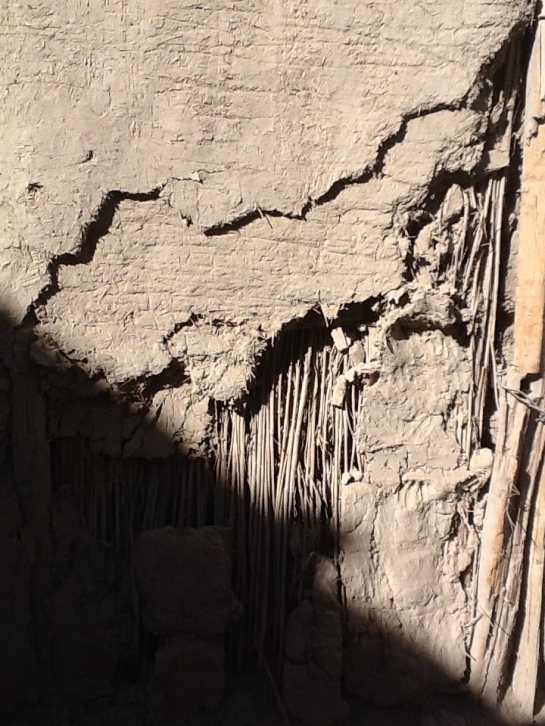

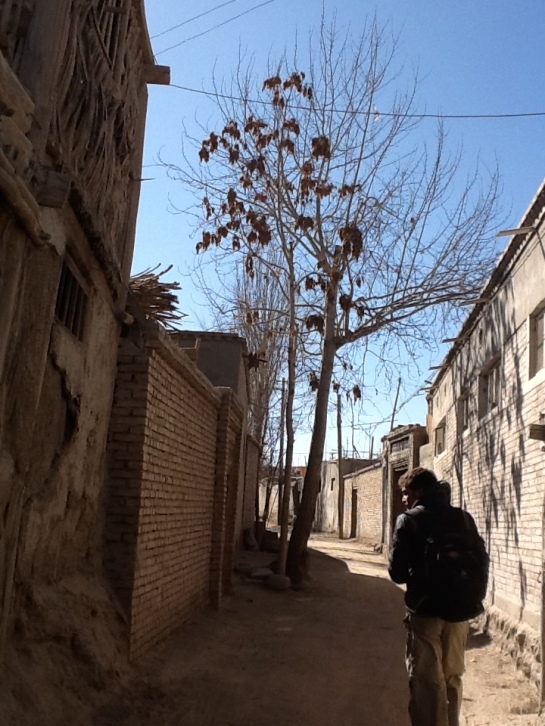























Until mosque let out the town was nearly silent. Ali told me that 100% of men go to mosque, and I didn’t believe him, for this isn’t the case in Urumqi or Kashgar. But in Keriya the entire town is empty for that one hour, barely a man to be seen on the streets, ‘cept a few policemen, restaurant owners, and entrepreneurs selling sliced fruit and snacks to the mass of hungry men emitted at four pm. The entire place goes from bustling to deserted in the quarter-hour before three.
We walked by the brother’s naan shop and talked to the lively worker who makes naans nonstop during the day. He lived in Beijing – in Shangdi for five years – and yet he too has returned to Keriya, to a small and steady job in a town that speaks his tongue (for there are near no Han Chinese in Keriya – they’re kind of like elephants: out of place and easy to spot).
When mosque let out there was first a trickle and then a flood, a veritable flood of men in black coats and tall hats. For half an hour women were scarce on the street, their numbers overwhelmed by the flow of men from the mosque back into their everyday lives. I felt baren, almost naked, for not wearing a headscarf. An object of attention – not critical or aggressive, just slightly startled, unsure attention. as in, HELLO! I’M OUT OF PLACE HERE! Almost all women here wear headscarves of some type, even younger children. In Aksu I saw one or two women with all but their eyes covered; in Kashgar, perhaps five percent (but some older women also completely cover their faces with loose brown shawls); and here, 99%of women wear headscarves, and in certain areas of town, 15-20% of them are completely covered, with but their eyes showing (though no one wears those brown shawl things). Wearing a headscarf has ceased to be a personal religious decision: it’s a community ultimatum, and there’s enormous unspoken pressure to conform.

As we made our way toward the mosque to find Ali, J was approached by a boy who wanted to speak English with him. This guy, it turns out, works as an interpreter in Urumqi and is home for the holiday. He seemed genial enough, and the two were planning on heading back around the same time, so they exchanged numbers. Which drew a huge crowd – five, then ten, then thirty men encircling them, just looking. The more men crowded round them the more came over to look and the larger the circle grew. This is a China phenomenon: whenever there are people crowding around something, more people have to go over and look. It’s also true that, until the barrier is broken (by a local interacting with us), people generally won’t intrude, will stare but won’t approach (except for the occasional “hello!”).
Keriya is noticeably more conservative than Kashgar – it’s like I’ve been traveling along an exponential graph, from Urumqi (comparatively liberal and free) to Aksu (moderate) to Kashgar (conservative but modern) to Hotan (conservative, not very modern) to Keriya (as conservative as rural Texas). I’m curious to know what happens further down the loop, to the towns no one I know has seen before, no one I know comes from: Niya, Qiemo, Ruoqian. But perhaps that will happen another time, in the summer when I travel to Kashgar once again.
Another interesting point: everyone in Kashgar thinks of themselves as more cultured (and, for northern Xinjiang, people in Yili/Ili/Gulgha take some pride in their hometown too). Hotan is seen as a backwater bayou: more crass, less historically significant, less refined (in the same way Savy New Yorkers might view uneducated Bostonians with their impenetrable accents, or the way the rest of the states views Alabama or West Virginia). But – I still like it, for the town is penetrated with an air of authenticity, like a wild west town that hasn’t been made into a film location.
A short anecdote: when I met them in Hotan, J told me that every meal he’d eaten had some form of mutton in it. Nothing is without meat (except breakfast, which is generally bread, jam and maybe yogurt). Several weeks back he, C, S and Adil went to a Uighur restaurant together for lunch. C is a vegetarian, and so she tried to order noodles (laghman) with vegetarian topping. Adil went to talk to the cook and a few minutes later he came back. “He can’t do it”. “What?” “He says he can’t make laughman without meat” (as in, it’s literally impossible for the man to not put meat into the vegetable and sauce topping for the noodles). And, indeed, our meals yesterday were: naan and fruit jam for breakfast, pilaf with yogurt for lunch, and noodles and kebabs for dinner, all chosen for us by our friends and local dietary decision-makers.
Hotan
Is dusty.
Ita an odd town, a city that feels more centralized and whole than Kashgar. There is no preserved old town or attempted renovated quarters, just old buildings blended in with the new, dusty lanes and crowded, chaotic roads with modern shops and hospitals next to medicine shops selling snake skins and saffron. There’s hardly a Han face to be seen, though there’s obviously a strong Han force in the government, as can be seen by the Chinese brand stores popping up around town.
Today was grey, and thus the city looked a bit despairing. Grey. Very dusty.

I met up with J and his local friend Ali right after breakfast. We then met up with Ali’s girlfriend, a cheery and bright-eyed girl wh studied Psychology in Guangzhou and is now relegated to working in some boring government office, per parents’ wishes that she stay closer to home. The two have known each other since kindergarten, and thus have the familiarity of family, an invisible thread that connects them wherever they go.
The visit to Hotan was, for Ali, really to spend the day with his girlfriend. So we wandered around the town several times, J and I chatting and following them until we figured out that they truly had no destination in mind and we’d actually walked in a circle. Then “dirty” (brown) pilaf for lunch, a wander through the bazaar (big, dirty, lived in, crowded, chaotic, lively) where the girlfriend bought and put on a headscarf – she normally doesn’t wear one, but in certain areas of Hotan every woman does, and she felt awkward without it. People stare at me anyway (mostly trying to judge if I’m a local minority or Russian), so I’m no longer phased.
Post lunch we wandered through the medicine street, where craftsmen bang out metalware next to burlap sack upon burlap sack of tea and herbs. Then we took a taxi out to the jade market next to a stony riverbed where dozens of men were combing the shores and shales for hidden treasure. Then taxi back into town for coffee at a fast food place, a few errands run, and then we hopped into a black cab for the nearby town of Karakash, famous for black jade and a particularly delicious night market (more on this and certain social customs later).
Now, back to Keriya to spend the night (and the next five days) in a small oasis town.
Hotan, Exhaustion (2/5)
The “express” bus from Kashgar to Hotan takes seven and a half long, winding hours – without break (It was a good thing I didn’t have coffee this morning).
We stopped three times for ID inspection – every time we went over a county bounty: Yarkand, Kargilik, and Hotan (apparently Guma/Pishan is too small to warrant a stop). But no restrooms, no small shops for water and food.
After Kargilik it was dark, a long three hours of hurdling through the desert in the black night, occasional shops and stops lit up by the road.
Leaving Kashgar (2/4)
I spent far more time in Kashgar than I expected – a total of nine nights, split between Maitian and following Tristan around as he showed me the tourist spots around the city, and Pamir, where I spent time hanging out with locals and travelers and not really knowing what to do in the city after seeing everything there was to see.
The longer I stayed in Kashgar the less I liked it.
These past few days I spent a lot of time with Yusuf from Poskam (I believe I mentioned him before – he was one of the semi-locals staying at Maitian while attending training classes for the government test, the basketball major with strong interests in both break and traditional dancing). Yusuf doesn’t belong in Kashgar. He’s Uyghur, he’s Muslim, but he’s also more of a radical/free thinker who is kind of stuck here – stalled plans to leave for the states that never materialized after that July.
He’d like to go to the states, or even other parts of China and study dancing, become a choreographer (last night a few of us went to a Uyghur club and he tried to teach us traditional dance – not the best idea, in a club, as beginners inevitably crash into everyone) or a trainer. But most likely he’ll end up a police officer or PE teacher, married to someone his parents choose after he secures a house and a car, stuck in a smalltown life.
And Kashgar just seems like that – stalled, walled in, security cameras everywhere, people paranoid about police and spies, police checks everywhere and armed men in camouflage perched before government buildings. An oppressive, stifling, dusty atmosphere. And appropriately, when I left to day the sky was a dirty, hanging grey. Oh, Kashgar, you could be so beautiful.
Now – I’m on a never-ending bus ride through desert wasteland to Hotan, and from there I’ll go to Yutian/Keriya (于田 كېرىيە) tomorrow and stay with J’s co-worker’s sister’s family for about five days, hanging out with J and his local friends before completing my circle around southern Xinjiang to places no one I know has ever visited (because its mostly tiny towns and desert).
Tashkorgan (1/31)
Where to start? These past few days have been wild, full, a little bit different.
Yesterday I prepared for leaving for Tashkurgan – packing, washing, going to the grocery store with Chen to buy things for the family we are staying with – chocolate, big containers of yogurt, a cover for their coverless pot, candy for the kids, a stapler, cookies and biscuits for tea. I bought headscarves from the bazaar, to wear around town in Tashkurgan (it’s easier for everyone if I look like a local, or at least like I’m from Xinjiang), plenty of dried fruit, and had vegetables and garbanzo beans for lunch – fresh food before I arrive in the land of mutton and dried bread.
There were four young British teachers from Chongqing staying at the hostel and we walked around town a bit together, chatted, and made plans for dinner. I had also promised to have dinner with one of the guys studying for the government exam I met at the hostel, one of those fierce-looking Uyghurs who’s actually more teddy bear than grizzly, a basketball major (as yes, that’s actually a major in China) who’s also into hip-hop (popping) and traditional dance. So at half-past-seven seven of us – three Brits, a scot, a Han Chinese who studied in Holland, a Uyghur and myself, met in the square before the mosque and headed over to Mawlan’s restaurant for a decent dinner of Uighur food done well. (To put in another plug for the guy, Ak Altun right off Renmin West Road is easily the best reasonably-priced Uyghur restaurant in town – all the dishes are done really well, the interior is quite luxurious, the service is good, and we each paid but twenty-three yuan). My poor friend (who goes by the name Yusup – the Uyghur Joseph) speaks no English, as he went to a special sports training school in Urumqi for high school, and the Brits speak menu Chinese. This was Yusup’s first time not just eating with foreigners, but conversing with foreigners (aside from our few encounters in the hostel). But it all went okay and after dinner Yusup and I went for a spin around town on his motorscooter and then walked the Kashgar University campus and the frozen East Lake with all its lights, walked and talked, walked and talked.
Yusuf is from Poskam, a small town/city in southern Kashgar most famous for its oil reserves. His mother is a nurse, his father an account or some such office worker. Originally be planned on going abroad after high school, joining a professional American basketball team, but that takes an incredible amount of money for an average family, so he stayed in Kashgar and now regrets just focusing on basketball, as there aren’t too many employment options available here – PE teacher, police officer. That’s it.
We then went back and had tea, I took one last hot shower and then climbed into bed.
This morning I woke up before even the first call to prayer, at a dark eight am. We left for the bus station around nine, the sky still pitch black. And waited. And waited. For you can’t buy tickets until the bus arrives. The first time I asked they told me to come and buy tickets at 9:30, and get on the bus at ten. But today the bus didn’t arrive until after ten, we got on around ten-thirty, and it didn’t leave until after eleven.
The bus was full of Tajiks, Han and Uyghur – the makeup of Tashkurgan. Tajiks all live in the countryside, with Han, Hui and Uyghur making up all the shopowners and town residents. According to my companion, Tajiks can’t do business – they have no mind for money. They’re herders, farmers. And, from what I’ve seen, that seems to be fairly true.
We drove through desert and dust-colored desert mountains. Then, almost suddenly, the road rose and we entered the snow region (though there’s not much snow on the ground). Windswept snow peaks and jagged grey rock towering above a rock strewn wasteland. Austere, immense, and starkly beautiful.
The town itself is tiny. Really tiny. It’s barely even a square kilometer, and the highest building is three stories, though most are two. A street of shops, a small farmers market, and perpendicular to that one street of restaurants and government buildings (like everywhere else, the tallest and newest in town).
We’re staying in the countryside, a mere few hundred meters down the street and across a few barren fields from the town. It’s an actual Tajik house, with a family of five or so – mother, two unmarried daughters of eighteen and twenty-four, a son, a father (who I never saw, as he works as a herder), and a charming dirty white kitten. Their house is made of mud-straw brick, a courtyard of dirt and four unconnected rooms – a winter all-purpose living room/kitchen/bedroom, guest room, a parlor for entertaining guests, and another empty guest room for holding big family gatherings, everything covered in miles of carpeting and embroidery, though the carpets are machine-made, no longer wool. It’s a simple house, neither rich or poor. Thousands of kuai of tapestries, and yet they still use dung-burning stoves to heat the rooms and cook food.
Unlike Uyghurs they don’t observe a whole set of polite social rituals. We entered, gave them the bag of sweets and cakes, and then just sat down. A bowl of milk tea, some bread, and then we wandered around town before having dinner with some Germans working in Nujiang, Yunnan who we met on the bus. And then… It’s a little too late to write much more. But, so far, Tashkurgan is rather interesting.
And yes, we might be using dung stoves, but there’s still full cellphone coverage for my iPad to go online over 3G…
Emo Tajiks and Unsuprising Days (2/1)
Tashkurgan: nothing is unexpected about Tashkurgan, except maybe that the town is so small and all the buildings are exactly the same (light butter yellow, two stories with shops on the bottom and restaurants on the top). The entire population of the region of Tashkorgan – half the Tajik population of China – could fit into the university complex where I live.
Today also nothing unexpected happened. Tajiks are like that – less substantial of a presence. Go with the flow, casual, welcoming but not exuberant, 随意. And the town is just a Chinese town inhabited by Tajiks and run by the police.
This morning we went to the cultural center, which ended up being nothing more than a stage for performances, a stuffed mountain goat, a stuffed yak, and a pile of dusty posters outlining the proposed development of Tashkurgan, 2010-2020. The whole town is to be changed, touristified, more houses knocked down for parks and plazas and tourist areas, more schools built, more village health clinics, yet more police stations.
After our disappointing trek through the center we met up with a random friend of Chen’s, Z, an emo Tajik youth of eighteen studying medicine in Kashgar, a Tajik as un-Tajik as one can be, save the red hair and grey eyes. He’s spent most of his youth in Kashgar, where he attended Chinese-medium middle school and then did his associates in medical care. Tashkurgan he visits only during the holidays. Tajiks tend to be more relaxed with their religion (in some ways Tajiks are Muslim as village Chinese are Buddhist), and this boy has none at all. He was born Muslim, but knows nothing about it, and cares to know nothing about it. While many Tajiks participated in bilingual Uyghur-Chinese programs, he went to a Chinese school, and can only read Chinese.
After a failed attempt to visit a scholar in the countryside (he was out till the afternoon), we went back into town for a brunch of dry, greasy pilaf, and then visited Z’s home. His house was noticeably nicer than the place we lived in the countryside: made of brick, with actual wood furniture and fixings, four rooms filled with embroidery and bedding, plus an actual kitchen. Nearly every Tajik room is the same: a few non-connected rooms, each with a raised platform covered in carpets and stacked blankets taking up most of the space, embroidery or other hangings covering the walls. The windows between the main hall and the kitchen were covered with colorful embroidery and poster photos – two smiling, chubby Caucasian babies, and Sharukh Kahn (a Muslim Indian actor quite popular in China). Again, all of the embroidery was done by the women in the family – his mother and two younger sisters. And like the other women I’ve met, his mother neither works nor speaks Chinese. No one in their family works as his father, who was a police officer, passed away over ten years ago. They still receive his father’s salary and government social security – probably not a lot of money, but obviously enough for them to live comfortably in a simple way.
The scholar we eventually visited, but that’s a longer story, and I’ll write while I’m on the bus back to Kashgar tomorrow.
The Translator (2/2)
Chinese Tajiks are mountain people: letterless people, semi-nomads, herders. A people almost without literature, half-isolated from the outside world. For this reason their situation is quite different than other minorities like Uyghurs and Kazakhs. They have no written language, no literature, and not much known history, a people whose identity has been passed down through transient culture – dance, song, embroidery, clothing.
Today we met with a translator, a retired government worker my father’s age who used to translate between the Chinese government officials and the non-Chinese-speaking locals, a retired Tajik who now spends his time teaching private classes and writting tomes on Tajik culture and history, in Uyghur. We spent two hours this afternoon at his place just chatting up culture and local educationalhistory.
The first school here was established in 1936. At that time Uyghu was the lingua franca of Xinjiang, and school here was taught in Uyghur. This was true up until the 1980s and 90’s when schools started instituting a bilingual program: some classes taught in Uyghur, some in Chinese. The main reason for this switch was to fit the job market: students who could only speak and write Uyghur couldn’t find decent jobs, couldn’t function in modern China, and couldn’t attend college. There is no real plan for bilingual education: Uyghur teachers teach in Uyghur, Chinese teachers teach in Chinese, and most science and math classes are taught in Chinese, regardless of the teacher’s ethnicity.
Most teachers now are Chinese, temporary teachers who work here for a year or two. The rubbish of China according to a few. As with government positions: those who can don’t come to Xinjiang at all. They get jobs in Inner China. Those who do come to Xinjiang are thus (often) less qualified. And the most qualified of those work in the bigger cities. The less qualified come to southern Xinjiang. And the least qualified of those, the people who can’t find work anywhere else, end up in wayward rural areas like Tashkurgan. Teachers here, he translator said said, don’t always have the required experience and ability to be teachers. Basically, as long as they can speak Chinese, they get the job. And the low quality of teachers, he noted, is a major problem with education here. Qualified people from outside won’t come, and the Tajiks haven’t yet trained enough of their own. Change will come, he said, slowly. Education will improve as more and more Tajiks go on to university and return to teach (and most Tajiks do return, as employment is hard to find elsewhere, and nowhere else in China is their language the common tongue on the streets)
Before the 1990’s very few Tajiks could speak Chinese, and our scholar used to work as a government translator. Because, of course, the government spoke Chinese and the people didn’t, it not being a government of the people. Our scholar was a bit critical of the government (like, hello, everyone else in China). Here, like other places in China, all the people in power are outsiders. And they little understand the locals or local needs. Tashkurgan, for example, has not a single public toilet (actually, it has one, but it’s permanently locked), yet it has a huge empty cultural center (also without toilets). Why? the scholar asked. Because, of course, government officials sit in their offices all day and have no need for public toilets.
Development is commercial – Chinese, not Tajik in style. Within a few years the town will look like a Disney resort. Lucrative businesses started by locals are soon taken over by outside businessmen (who then skip out on taxes, due to government incentive programs for ‘investing’ in western China. And every incident becomes an ethnic conflict.
If there’s one thing every minority group in Xinjiang agrees on its government overreaction to singular incidents, and the tendency to turn every issue into an ethnic conflict.
Several times in recent history one person has caused some trouble in the area (several years ago a single Uyhur trying to skip over the border killed several policemen in a scuffle) and for weeks or months afterwards the area was covered in military police and the skies werebuzzing with military helicopters. One person acts out, and the entire area falls under suspicion, suspect to close police supervision. Everytime something happens what’s mentioned first is the person’s ethnicity. When someone knives children, cheats people at a market, or steals something in Inner China, we don’t see them as reflective of the entire population of Sichuan or Henan or Hubei or anywhere else (well, sometimes… there’s still a lot of stigma around people from Henan). We see it (and the news portrays it) as a singular incident. But, if that person is a muslim ethnic minority, then it automatically becomes an ethnic issue, and everyone of that ethnicity is suspect of similar intentions. I joked (and it’s not a joke – unfortunately it’s quite true) that according to Chinese public television, Uygurs can dance, steal and murder. And that’s about all. Everywhere in China, what the country lacks is nuance.









